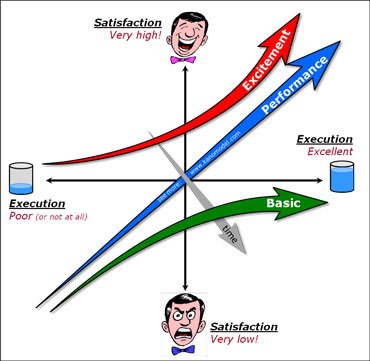
Chris Shinkle introduced us to the Kano model of customer satisfaction while internally presenting his Stop Doing Kanban, Start Learning lecture that he delivered at this year’s LSSC.
The Kano Model of Customer Satisfaction:

As an outsourcing partner, this model has direct implications for SEP. The Performance axis represents our client’s needs in a solution. In theory it does at least. In reality some of the Low customer satisfaction is not due to poor performance but the fact that performance and specifications are misunderstood. Why? Performance expectations are typically detailed in a requirements document or specification.
Document driven development has known issues:
- We can’t get the scope right up front. (Words mean different things.)
- We discover new ideas we want to implement after the scope has been defined. (We know what we want when we see it.)
- Markets change quickly so assumptions might prove to be invalid.
Lean/Agile methods address the issue but the means in which the development partner is engaged drives overall satisfaction. When the work arrangement is not so specification driven it leaves room for the scope to float; SEP can pivot with the client to pick up newly discovered features and ideas. Even when SEP performs an upfront discovery process we will still discover things as we go along.
Clients are more satisfied when the development partner (SEP) over-delivers. They are dissatisfied when something isn’t “caught”. So a lot of customer satisfaction is based on Expectation.
We also see that Lean/Agile partnerships seem to encourage more engagement and what better way to express expectation. This sure makes the job of building the right product easier. The engagement is based on a relationship not a specification, producing a rewarding experience.